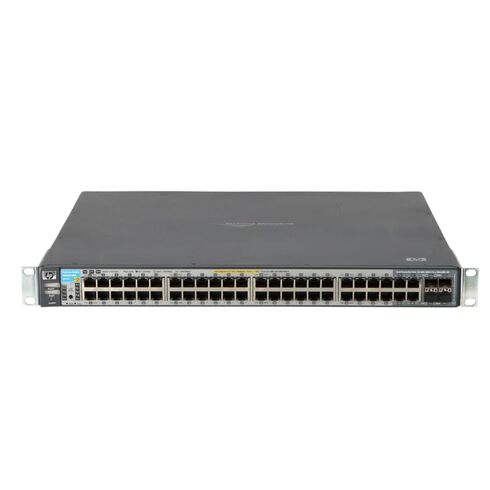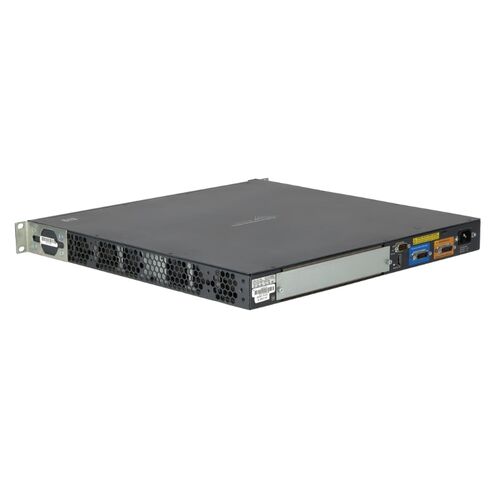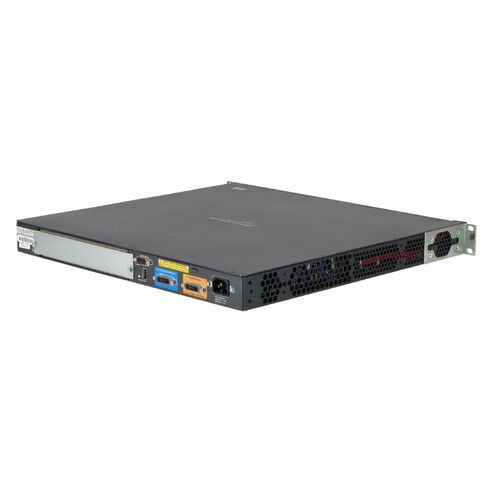JG894A HPE FlexFabric 5700-48G-4XG-2QSFP+ Managed Network Switch.
- — Free Ground Shipping
- — Min. 6-month Replacement Warranty
- — Genuine/Authentic Products
- — Easy Return and Exchange
- — Different Payment Methods
- — Best Price
- — We Guarantee Price Matching
- — Tax-Exempt Facilities
- — 24/7 Live Chat, Phone Support
- — Visa, MasterCard, Discover, and Amex
- — JCB, Diners Club, UnionPay
- — PayPal, ACH/Bank Transfer (11% Off)
- — Apple Pay, Amazon Pay, Google Pay
- — Buy Now, Pay Later - Affirm, Afterpay
- — GOV/EDU/Institutions PO's Accepted
- — Invoices
- — Deliver Anywhere
- — Express Delivery in the USA and Worldwide
- — Ship to -APO -FPO
- — For USA - Free Ground Shipping
- — Worldwide - from $30
Overview of HPE JG894A FlexFabric Switch
Key Product Details
- Manufacturer: HPE
- Part Number (SKU): JG894A
- Product Type: Network Switch
- Sub-Type: 48 Ports
- Mounting: Rack-mountable (1U)
Core Features
- Device Type: Layer 3 Managed Switch
- Ports: 48 x 10/100/1000 + 4 x 10G SFP+, 1 x 1G SFP+, 2 x 40G QSFP+ uplinks
- Switching Capacity: 336 Gbps
- Performance: 250 Mpps throughput
- Routing Table Capacity: 128 entries (IPv4 & IPv6)
- MAC Address Table Size: 128k entries
- Jumbo Frame Support: Up to 10,000 bytes
Advanced Networking Protocols
- RIP (v1, v2), IGMP (v2, v3)
- Static IPv4 & IPv6 Routing
- Dynamic Routing Protocol Support
Management and Authentication
- Remote Management Protocols: SNMP (v1, v2c, v3), Telnet, SSH, CLI
- Authentication Methods: Secure Shell (SSH, SSHv2), TACACS+, Radius
Network Features and Support
- Flow Control, DHCP, ARP Support
- Port Mirroring, Weighted Round Robin Queuing
- Quality of Service (QoS), Access Control List (ACL)
- Multiple Spanning Tree Protocol (MSTP)
- Equal-cost Multipath (ECMP), LLDP Support
- Data Center Bridging (DCB), FCoE Support
Compliance and Standards
- IEEE 802.3, 802.1Q, 802.1p, 802.1X
- 802.1d, 802.3ae, 802.3ab, 802.1ag, and more
Hardware Specifications
- RAM: 2 GB SDRAM
- Flash Memory: 512 MB
Expansion and Connectivity Options
- 48 x RJ-45 Gigabit Ethernet Ports (1000BASE-T)
- 4 x SFP+ Ports (Gigabit / 10 Gigabit)
- 2 x QSFP+ Ports (40G Uplink)
- Serial Console Port (RJ-45)
- USB 2.0 Port
Power Specifications
- Power Supply: Internal, up to 2 installed (1+1 redundancy)
- Operational Power Consumption: 175W
Ports
The HPE FlexFabric 5700-48G-4XG-2QSFP+ Managed Network Switch is equipped with a versatile range of ports, making it an ideal choice for businesses that require high-performance networking solutions. This switch offers a total of 48 Gigabit Ethernet ports, 4 10Gb Ethernet ports, and 2 QSFP+ ports.
48 Gigabit Ethernet Ports
The 48 Gigabit Ethernet ports on the HPE FlexFabric 5700-48G-4XG-2QSFP+ provide users with the ability to connect a large number of devices to the network. These ports offer fast and reliable data transfer speeds, ensuring seamless communication between devices. Whether it's connecting computers, servers, or other networking equipment, the abundance of Gigabit Ethernet ports allows for efficient connectivity and smooth data transmission.
High Bandwidth
With Gigabit Ethernet support, users can enjoy high-speed data transfers of up to 1000 Mbps. This high bandwidth is particularly beneficial for bandwidth-intensive applications such as video streaming, data backup, and file sharing. It ensures that network traffic flows smoothly without any bottlenecks, minimizing latency and maximizing productivity.
Scalability
The large number of Gigabit Ethernet ports enables businesses to scale their networks as their needs grow. As more devices are added to the network, having a sufficient number of ports ensures that each device can be connected without sacrificing performance. This scalability feature is especially important for businesses that anticipate expansion or have dynamic networking requirements.
Network Segmentation
With 48 Gigabit Ethernet ports, users have the flexibility to segment their network into different VLANs (Virtual LANs). VLANs allow for logical separation of devices within a network, improving security and performance. By dividing the network into smaller, isolated segments, users can control access to resources and minimize the risk of unauthorized access.
Redundancy and Resilience
The HPE FlexFabric 5700-48G-4XG-2QSFP+ switch provides redundancy and resilience through its multiple Gigabit Ethernet ports. In the event of a port failure, traffic can be automatically rerouted through alternate paths, ensuring uninterrupted connectivity. This feature is crucial for businesses that require high availability and cannot afford network downtime.
4 10Gb Ethernet Ports
In addition to the Gigabit Ethernet ports, the HPE FlexFabric 5700-48G-4XG-2QSFP+ also features 4 10Gb Ethernet ports. These ports offer blazing-fast speeds, making them ideal for bandwidth-intensive applications and environments that demand high-performance networking.
Increased Bandwidth
The 10Gb Ethernet ports provide significantly higher bandwidth compared to traditional Gigabit Ethernet ports. With a data transfer rate of up to 10 Gbps, these ports are capable of handling large amounts of data with ease. This increased bandwidth is particularly beneficial for businesses that deal with data-intensive tasks such as virtualization, video editing, or large file transfers.
Reduced Latency
The higher speed offered by the 10Gb Ethernet ports results in reduced latency, allowing for near-instantaneous data transfers. This is especially important for real-time applications that require low latency, such as voice and video conferencing or online gaming. The reduced latency ensures a smooth and seamless user experience without any noticeable delays.
Efficient Data Center Operations
For data centers or server environments, the 10Gb Ethernet ports enable faster communication between servers and storage devices. This improves overall data center performance and reduces bottlenecks, ensuring efficient operations and maximizing productivity. By leveraging the high-speed capabilities of the 10Gb Ethernet ports, businesses can achieve faster application response times and better resource utilization.
Future-Proofing
As technology continues to advance, the demand for higher network speeds will only increase. By investing in a switch with 10Gb Ethernet ports, businesses can future-proof their networks and avoid the need for costly upgrades down the line. This feature ensures that the HPE FlexFabric 5700-48G-4XG-2QSFP+ switch remains relevant and capable of meeting the evolving networking demands.
2 QSFP+ Ports
The HPE FlexFabric 5700-48G-4XG-2QSFP+ is equipped with 2 QSFP+ (Quad Small Form-Factor Pluggable Plus) ports, offering even greater flexibility and connectivity options.
High-Speed Connectivity
The QSFP+ ports support various high-speed networking technologies, including 40 Gigabit Ethernet and InfiniBand. These ports enable businesses to connect to high-performance devices or aggregate multiple connections into a single high-speed link. This level of connectivity is particularly beneficial for data centers or environments that require ultra-fast speeds for demanding applications.
Link Aggregation
The QSFP+ ports can be used for Link Aggregation, allowing users to combine multiple physical connections into a single logical connection. This not only increases overall bandwidth but also provides redundancy and load balancing capabilities. Link Aggregation ensures efficient utilization of network resources and provides increased reliability for critical applications.
Data Center Interconnect
For data centers that require interconnectivity between switches, the QSFP+ ports offer an efficient solution. By connecting switches using high-speed QSFP+ links, businesses can establish fast and reliable connections between different parts of their infrastructure. This allows for seamless data transfer between servers, storage devices, and other network components, enabling efficient data center operations.
Support for High-Density Environments
The QSFP+ ports are particularly beneficial in high-density networking environments where space is limited. The small form-factor of QSFP+ modules allows for dense port configurations, maximizing the number of connections in a limited space. This is especially important for data centers or network cabinets where rack space is at a premium.
Management Interface
The HPE FlexFabric 5700-48G-4XG-2QSFP+ Managed Network Switch offers a comprehensive set of management interfaces, ensuring ease of use and efficient network administration. This switch supports CLI (Command Line Interface), Web GUI (Graphical User Interface), and SNMP (Simple Network Management Protocol) management interfaces.
CLI (Command Line Interface)
The CLI is a text-based interface that allows network administrators to configure and manage the switch using commands. This interface provides granular control over the switch's settings, making it a preferred choice for experienced network administrators who are comfortable with command-based configurations.
Flexibility and Customization
The CLI provides greater flexibility and customization options compared to graphical interfaces. Administrators can execute complex commands, create scripts, and automate tasks, saving time and effort in managing the network. The CLI also allows for precise configuration adjustments, ensuring that the switch operates according to specific requirements.
Scripting Capabilities
The CLI's scripting capabilities enable administrators to automate repetitive tasks or execute complex configurations with ease. By creating scripts, administrators can ensure consistency across multiple switches and streamline their management processes. This feature is particularly valuable in large-scale deployments or environments that require frequent configuration changes.
Efficient Troubleshooting
In the event of network issues or errors, the CLI provides detailed diagnostic information and troubleshooting capabilities. Administrators can execute commands to gather real-time data, monitor network traffic, and identify potential bottlenecks or misconfigurations. The CLI's ability to display comprehensive information aids in efficient problem resolution and reduces downtime.
Advanced Configuration Options
For advanced network configurations, the CLI offers a wide range of options that may not be available through graphical interfaces. This includes advanced routing protocols, VLAN configurations, or fine-tuning of Quality of Service (QoS) settings. The CLI's extensive command set ensures that administrators have complete control over the switch's capabilities.
Web GUI (Graphical User Interface)
The Web GUI provides a user-friendly interface that simplifies network management for administrators who prefer a visual approach. This interface allows for easy configuration, monitoring, and maintenance of the switch through a web browser.
Intuitive and Easy-to-Use
The Web GUI's graphical nature makes it accessible to administrators with varying levels of technical expertise. Its intuitive design guides users through the configuration process, reducing the learning curve associated with command-based interfaces. This user-friendly interface is particularly beneficial for small to medium-sized businesses that may not have dedicated network administrators.
Visual Representation
The Web GUI often provides visual representations of network topologies, making it easier for administrators to understand and manage complex networks. It allows for drag-and-drop configurations, visual status indicators, and interactive maps, providing a comprehensive overview of the network infrastructure. This visual representation enhances administrators' ability to monitor and troubleshoot network issues effectively.
Real-Time Monitoring
The Web GUI offers real-time monitoring capabilities, allowing administrators to view network statistics, traffic patterns, and device statuses in a graphical format. This visibility enables proactive network management, as administrators can identify potential issues before they impact network performance. Real-time monitoring enhances network security, performance optimization, and overall network reliability.
Simplified Configuration
The Web GUI simplifies the configuration process by presenting options in a user-friendly manner. Administrators can easily navigate through menus, select desired settings, and apply configurations without the need for complex command inputs. This reduces the chance of configuration errors and speeds up the deployment process.
SNMP (Simple Network Management Protocol)
SNMP is a widely used network management protocol that allows for centralized monitoring and management of network devices. The HPE FlexFabric 5700-48G-4XG-2QSFP+ switch supports SNMP, enabling integration with network management systems for comprehensive control and visibility.
Centralized Monitoring
SNMP allows administrators to monitor the switch's performance, health, and status from a central management system. This centralized monitoring capability provides a holistic view of the entire network infrastructure, enabling administrators to proactively identify and resolve issues. By receiving real-time alerts and notifications, administrators can ensure optimal network performance and minimize downtime.
Network Analysis
SNMP also facilitates network analysis by collecting and storing data from the switch. Administrators can analyze this data to gain insights into network usage patterns, traffic trends, and device performance. These insights help in capacity planning, identifying potential bottlenecks, and optimizing network resources.
Integration with Network Management Systems
The SNMP support enables seamless integration with various network management systems (NMS), allowing administrators to manage multiple devices from a single interface. This integration streamlines network administration tasks by providing a unified platform to monitor and configure switches, routers, and other network devices. It simplifies the management process, reduces administrative overheads, and enhances overall operational efficiency.
Automated Configuration and Provisioning
SNMP can also be used for automated configuration and provisioning of network devices. Administrators can remotely configure switches, deploy firmware updates, or push configuration changes using SNMP-based automation tools. This automation capability saves time and effort, ensuring consistent configurations across the network and reducing the risk of human errors.
Features
The HPE FlexFabric 5700-48G-4XG-2QSFP+ Managed Network Switch offers a comprehensive set of features that enhance network performance, security, and manageability. This switch supports Layer 2 switching, Layer 3 routing, Quality of Service (QoS), Virtual LAN (VLAN) support, IPv4 and IPv6 support, Spanning Tree Protocol (STP), Rapid Spanning Tree Protocol (RSTP), and Multiple Spanning Tree Protocol (MSTP).
Layer 2 Switching
The Layer 2 switching capability of the HPE FlexFabric 5700-48G-4XG-2QSFP+ switch allows for efficient data forwarding at the Ethernet level. It enables the switch to forward traffic based on MAC addresses, providing basic connectivity and network segmentation.
Efficient Data Delivery
Layer 2 switching ensures that data packets are delivered to the intended destination efficiently within a local network. By using MAC addresses to make forwarding decisions, the switch eliminates the need to route packets based on IP addresses. This results in faster data transmission and reduced network congestion.
Enhanced Network Security
Layer 2 switching enhances network security by allowing administrators to implement access control policies at the Ethernet level. By controlling which devices can communicate with each other based on their MAC addresses, administrators can prevent unauthorized access and mitigate the risk of security breaches. This feature is particularly important in environments where network segmentation is crucial for compliance or data protection.
VLAN Support
The HPE FlexFabric 5700-48G-4XG-2QSFP+ switch supports Virtual LANs (VLANs), which enable logical segmentation of a network. VLANs allow administrators to create separate broadcast domains, improving network performance, and security. By isolating groups of devices within a VLAN, administrators can control access to resources and limit the propagation of network issues.
Q-in-Q Support
The switch's Q-in-Q support allows for further VLAN scalability and flexibility. Q-in-Q is a technique that encapsulates VLAN-tagged frames within another VLAN tag, enabling multiple VLANs to be carried over a single trunk link. This feature is particularly beneficial for service providers or organizations that require multi-tenancy support or need to extend VLANs across different network domains.
Layer 3 Routing
The Layer 3 routing capability of the HPE FlexFabric 5700-48G-4XG-2QSFP+ switch enables packet forwarding based on IP addresses. This allows for inter-VLAN routing, enabling communication between different VLANs and subnets.
Inter-VLAN Routing
Inter-VLAN routing allows devices on different VLANs to communicate with each other by routing packets between them. This feature eliminates the need for external routers, reducing complexity and cost in network deployments. It enables efficient communication between different departments or segments within an organization while maintaining logical separation.
Scalability and Flexibility
The Layer 3 routing capabilities of the switch make it highly scalable and flexible. Administrators can easily add or modify IP subnets, allowing for seamless network expansion. This flexibility is particularly important in growing organizations or dynamic network environments where frequent changes to IP addressing and routing configurations are required.
Dynamic Routing Protocols
The switch supports dynamic routing protocols such as OSPF (Open Shortest Path First) and RIP (Routing Information Protocol), enabling automatic route updates and efficient packet forwarding. Dynamic routing protocols adapt to changes in the network topology and find the most optimal path for packet delivery. This ensures efficient and reliable routing, minimizing network congestion and maximizing performance.
IPv4 and IPv6 Support
The switch supports both IPv4 and IPv6 protocols, ensuring compatibility with modern networks. IPv6 support is particularly important as the world transitions from IPv4 to the next-generation IP addressing scheme. By offering support for both protocols, the switch ensures seamless integration with existing networks and future-proofs the network infrastructure.
Quality of Service (QoS)
The Quality of Service (QoS) feature of the HPE FlexFabric 5700-48G-4XG-2QSFP+ switch allows administrators to prioritize network traffic based on specific criteria. This ensures that critical applications receive the necessary bandwidth and latency requirements, guaranteeing optimal performance.
Traffic Prioritization
QoS enables administrators to assign different priorities to various types of network traffic. By classifying traffic into different queues based on criteria such as IP addresses, VLANs, or application types, administrators can ensure that time-sensitive or critical traffic receives preferential treatment. This prioritization prevents network congestion and maintains consistent performance for important applications.
Bandwidth Management
QoS also allows administrators to allocate bandwidth to different types of traffic based on their importance or requirements. By setting maximum bandwidth limits or reserving minimum bandwidth for specific applications or users, administrators can ensure fair sharing of network resources. This bandwidth management capability is particularly important in environments where multiple applications compete for limited network resources.
Voice and Video Optimization
QoS plays a crucial role in optimizing voice and video communication over the network. By prioritizing VoIP (Voice over IP) or video conferencing traffic, administrators can minimize latency and packet loss, ensuring clear and uninterrupted communication. This is especially important for businesses that heavily rely on real-time communication technologies for













